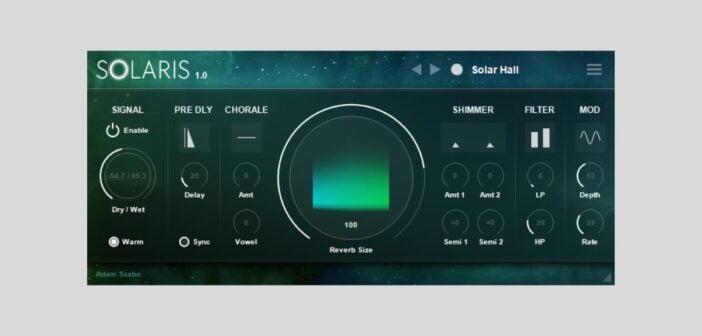Adam Szabo releases Solaris, a free shimmer reverb effect for Windows.
The ninth edition of the KVR Developer challenge is now live. As we have just announced in this article, there are 21 plugins submitted for this competition, all of which are free to download for anyone in the audio community.
One entry that stands out is certainly Adam Szabo’s Solaris, a shimmer reverb effect for Windows users only.
The plugin was developed with the renowned graphical programming software Flowstone, which doesn’t support Mac, unfortunately.
Apart from the host limitations, Solaris looks brilliantly designed and could well sit side by side with commercial reverb plugins due to both its great sound and appealing GUI.
It’s presented as a shimmering effect, so it’s not a generic Swiss-knife reverb but a specific one conceived for generating all sorts of ethereal and mesmerizing atmospheres.
Another great strength point of Solaris is its low CPU usage, which isn’t to be underestimated considering the fact we are talking about a shimmer reverb effect, which is usually quite CPU hungry.
The interface looks clean. It doesn’t bombard the user with many different parameters, which is good for quick user accessibility and handling creative sound design tasks with ease.
There are six main sections, equally spread out on both sides around the central big Reverb Size knob, which is the main parameter of the effect.
On the left, you can toggle on-and-off the effect, adjust the Dry/Wet control, and switch on the Warm button for warmer signal processing.
Interestingly, the Pre Delay of the reverb can be synced to the host tempo, a cool feature to be found in some commercial reverb effects like Crystalline by Baby Audio.
The Chorale section looks like a sort of vowel filter effect to add a human character to the reverberations, and the Shimmer panel on the right has two independent shimmer effects, which is great. This way, you can experiment by applying, let’s say, different transpositions to the reverbed signal for an even richer result.
Filter and Mod sections finish off the available controls of Solaris, which, even with a simple interface, can go quite deep in terms of sound design explorations.
We recommend trying it out, and if you like it, vote for it on the KVR Developer Challenge 2023 page.
Solaris is available as a 32 and 64-bit VST2 and 64-bit VST3 plugin for Windows only.
Download: Solaris (it doesn’t require an account to download it, but you need to be a KVR registered user to vote for it)
More:



15 Comments
Neytcev
onWaiting for Mac version, if possible!
its fraps not the f
onThis is indeed a shimmer reverb, a really good one with unexpected effects.
Wing Yee
onLove this, thanks for the insight!
CGrrr
onThis is the best plugin in KVR 2023 in my opinion, and I give it 5 stars.
sean
onPlease please please a Mac version! Please? <3
Numanoid
onThanks, this worked pretty well :-)
Defining what is Shimmer reverb, Sound on Sound put it like this:
“the so-called shimmer reverb effect, in which each note is followed by a reverberant wash of sound an octave higher than the original”
Is that basically what sets shimmer reverb apart from other reverb FX ?
mx
onin my personal understanding shimmer reverb is not necessarily exactly or only one octave higher, but theres always pitch shifting involved. i dont know where sos got their definition from, maybe shimmer was invented as just one additional layer until it was developed into wilder things.
you get devices with one and two octaves higher for example, or with other intervals.
so my basic definition of shimmer reverb would be that it is “a reverb tail which is pitch shifted in some way”.
ASJ
onAlthough I would not say it was “invented” that precise year, in 1986 Brian Eno entered the room where With or Without you by U2 was being mixed (Eno co-produced the track) and told the mixing engineers to change the intro by using loads of effects and feedback them into each other. We know a reverb was pitch shifted somewhere in that effects chain and the output sent back to the reverb. Then the track became a hit and started the niche popularity of “shimmer” as well
GaryG
onI think feeding the shifted reverb back into itself is an essential part of the ‘shimmer’. Without that it would be a static pitch shfted ‘verb, with it you get the typical shimmer ‘whoosh’ where the effect disappears up (or down) out of the range of human gearing.
John
onAnyone know of a free shimmer plugin that’ll work on mac?
Gery Zenz
onFlying-Reverb
Numanoid
onValhalla Supermassive one to check
Lalji 2
onVery nice
Camilo Arias
onI wish it was for MAC also :(
JEFF
onWHY DOES IT KEEP SAYING IM BLOCKED WHEN I TRY TO ACCESS THE WEBSITE.